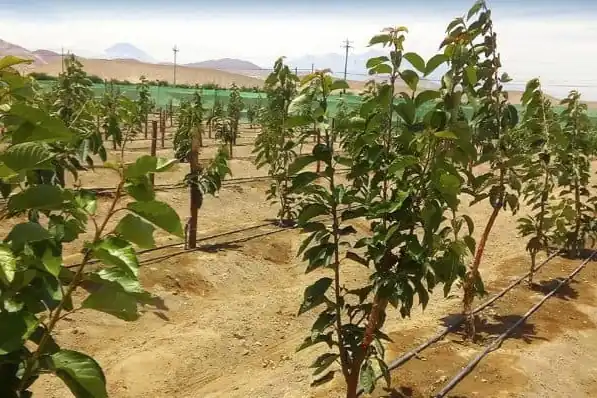Cherry Times Magazine online now! And get your free copy at Macfrut
29 Apr 2025
Pick up a free copy of Cherry Times Magazine at the Berry Area of Macfrut 2025 or browse the 94-page edition dedicated to the international cherry sector online now.
The main buyer of this fruit worldwide is the Asian country. For this year, it is estimated to reach a historic record of 600,000 tons. Its main supplier is Chile, which ships 91% of its production.
Peruvian agriculture could add a new protagonist to its list of potential export crops: the cherry. After a decade of trial and error, 2026 appears to be the right year for the variety adapted to local climatic conditions to finally emerge.
The discovery promises to boost, in the long term, the chain required to ship this fruit to international markets. In this context, China takes on particular importance.

Gabriel Amaro, president of the Association of Agricultural Producer Groups of Peru (AGAP), explained the sector’s reaction to a crop that has been a pending matter on the agricultural agenda for at least 10 years.
“There are various companies that, in their diversification process, are testing varieties that can adapt in areas suitable for cherries. Some in Arequipa, Huancavelica, the border with Ica, but more in the highlands. Special light and temperature conditions are needed.”
Regarding this, he told Gestión: “I am sure that next year we will have the good news that we have found the right variety. Work is underway to achieve this.”
César Romero, specialist at the Directorate of Economic Studies under the General Directorate of Agricultural Policies of the Ministry of Agrarian Development and Irrigation (Midagri), reinforced this premise but clarified one point: “It is estimated that the first harvest could take place in 2026, although consolidating a commercially relevant volume will take roughly between 7 and 10 years.” He also listed other trial areas: Huaraz, Huancayo, and Ayacucho.
It should be highlighted that genetically adapted cherry trees, those commonly used in agro-export, take between 3 and 5 years to bear fruit, unlike seed-grown cherries, which require between 7 and 10 years.
The specialist added: “Once the variety is identified, cultivation must begin and its yield must be evaluated. […] Then phytosanitary protocols must be signed to access, in the case of fresh products, the destination markets with the required quality and safety certifications.”
He also explained why research has progressed slowly over the past decade: “Possibly, due to excessive heat, such a sensitive variety deteriorates; flowering is very limited, so yield decreases. Or the fruit size is not sufficiently large, technically acceptable, for international standards.”
Romero also drew a comparison with other delicate-skinned agricultural products: “Cherries behave differently from blueberries, which have adapted very well, as have raspberries and strawberries. Cherries are much more delicate.”
Amaro emphasized that “the main buyer of cherries is China.” In fact, for this year the Asian giant is expected to reach a historic record of 600,000 tons. Its main supplier is Chile, which ships 91% of its production.
Peru could compete later on, provided its efforts focus on strengthening the quality factor, an element that meets international requirements: “Once we have the product, we must open the market. If opening the market takes years, then developing the crop will also take years. However, if the authorities carry out their technical work together with us producers while also conducting diplomatic work with partner countries, market access for cherries could happen very quickly.”
The country can take advantage of the logistical window offered by the Chancay megaport. Through this route, a product can take about 21–23 days to arrive. Before its inauguration, the journey could take between 33 and 40 days.
Romero recalled that this commercial approach is already underway: “We have already sent some small volumes to China that have been received, but it is nothing. We cannot yet seriously talk about a cherry industry.”
Despite progress, continuing with scientific research is a step that cannot be interrupted, said the AGAP representative: “On top of everything, we need to acquire more varieties of genetic material.”
Source: AGROEXPORT
Image source: Viveros Los Vinedos
Camila Vera Criollo
29 Apr 2025
Pick up a free copy of Cherry Times Magazine at the Berry Area of Macfrut 2025 or browse the 94-page edition dedicated to the international cherry sector online now.
30 Sep 2024
The cherry harvest has been deemed a failure and similar conditions have affected sour cherries. Cherry growers are estimated to have lost 30 to 75 per cent of their crop this year. Governor Gretchen Whitmer asked for federal assistance to the growers.
11 Dec 2025
Aragonese cherries are set to enter the Chinese market thanks to Orchard Fruit, a family business led by Menchu Guerrero. Since 2017, the company has followed a scientific and export-driven strategy, inspired by Chile’s model, to bring premium fruit to global markets.
11 Dec 2025
An innovative study compares qPCR and dPCR to analyze genes linked to fruit cracking in cherries. Eight molecular markers were identified to support genetic improvement, early diagnosis and field strategies against cracking, a key challenge in cherry farming.